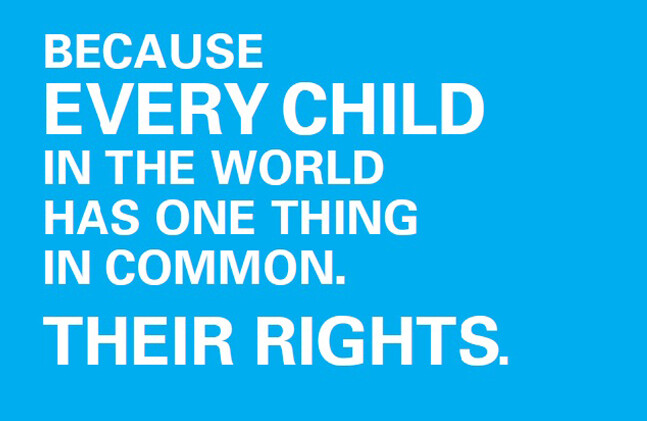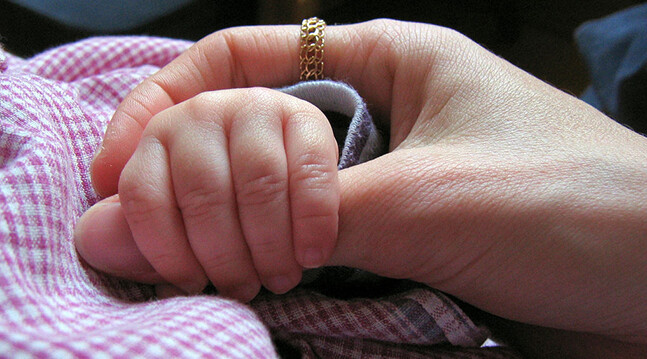"I have the right...to be treated like a human."1 By virtue of being human and part of the "human family" (as per international human rights language), children are entitled to human rights. Yet, domestic misunderstandings and concerns about children's rights continue to impede ratification of the Convention on the Rights of the Child (CRC) by the United States. In fact, America is one of only two countries that has not yet ratified the CRC (the other being Somalia due to internal governance issues). As the 25th anniversary of the CRC's adoption by the international community approaches this November, it is time to consider the nature and importance of children's rights and why the United States should ratify the primary international child rights instrument: the CRC.
What are Children's Rights? Children's rights recognize and support understanding of children as people, as the young person cited above and Melton (1983)2 have enunciated. These rights advance children's need for protection and provision and their place within family and society, including their right to participate. As human rights, these needs are formally recognized as just claims and requirements due to children. Thus, rights are not optional, and formalize certain needs as obligations from the state that require respect and consideration in international law. Rights ensure that we pay attention to children and that they are respected in our lives and societies. Accordingly, children's rights identify the key priorities for the state party in order to support children within its jurisdiction.
Children's rights were first established as a response to children's terrible suffering during World War I. The 1924 Geneva Declaration provides the first formal articulation of children's rights. It outlines that "mankind owes to the Child the best that it has to give."3 Despite the gender-exclusive language, this commitment continues to be true, inspiring many actors in relation to children's rights.
Since those early years, the international community has elaborated understanding of children's rights in different documents and events, including the 1990 World Summit for Children and the Special Session on Children in 2002 organized by the United Nations. In recognizing their human rights, these efforts essentially advanced the understandings and commitments about children.
The CRC is the key international instrument related to children's rights, resulting from preparations for the 1979 International Year of the Child. While the UN had already adopted a Declaration on the Rights of the Child in 1959, the government of Poland proposed in 1978 that the UN adopt a Convention on the Rights of the Child. Progressing from a Declaration to create international legal obligations in the CRC would mean that children's rights would be taken seriously, not simply reflecting voluntary actions if states desired. However, negotiations took far longer than originally expected, engaging states from around the world, including energetic U.S. involvement as well as participation by civil society.
The resulting CRC is now the most successful human rights treaty ever, with an unprecedented number of ratifications/accessions by states. It is important due to its elaboration of the full range of children's rights in international law and recognizing the range of requirements to develop and realize the child's full potential. In essence, these rights in the CRC encompass protection, provision, and participation, also known as the three "Ps." Unless the age of majority is obtained earlier, everyone under the age of 18 living in states parties to the CRC is considered a child (even though most adolescents would refuse this label for themselves).
The CRC is significant in providing a coherent framework and inspiring action for and with children in domestic and international efforts. Thus, children are no longer considered the property of others. In addition, children should not only relate to our concerns for the future since they are people here and now. The CRC also guides a right-based approach to efforts concerning children. This means that the instrument not only identifies goals and obligations but it can also support the process of implementation, or inform the efforts in relation to children. Accordingly, measures can be more effective over time through attention to such CRC principles as non-discrimination, maximum child development over time, and participation. In sum, as academics and such organizations as UNICEF and Save the Children have documented, the CRC has guided much progress around the world over the years.
CRC Ratification by the United States The United States signed the CRC almost two decades ago on February 16, 1995. As I will show, it is time to finally ratify it so that it may have greater relevance in the American context. Indeed, U.S. ratification would inspire meaningful action on children's rights not only domestically but also internationally.
The United States has already made some important steps to support child rights, including concerns about protecting children from armed conflict and sexual exploitation. It ratified the optional protocols (OPs) to the CRC on the involvement of children in armed conflict and on sale of children, child prostitution and child pornography, respectively, on 23 December 2002. Additionally, the U. S. Supreme Court eliminated a historical impediment to U.S. ratification of the CRC in Roper v. Simons. This decision in 2005 overturned the state practice of using capital punishment against those convicted of crimes committed while under 18 years of age. However, while protecting children from sexual exploitation, armed conflict, and capital punishment are important priorities in children's rights, they are not the only concerns. There are various other protection issues addressed in the CRC that the two OPs do not include. Examples include: respect of birth registration; the right to acquire a nationality; and combating illicit transfer and non-return of children abroad, in accordance with CRC articles 7 and 11. Moreover, protection must be advanced with attention to other children's rights in relation to provision and participation. Children's rights, like other human rights, are understood as equal, interdependent, and indivisible, where each right is equally important and fundamental to the child's dignity. As such, effective implementation of the child's right to protection requires the provision of meaningful services, including education, to avoid exploitation. Participation, also known as children's freedom to express views, which should be given "due weight" as per CRC article 12, is another important rights-based dimension. Participation encourages children to articulate their views because they should be both seen and heard in their families and society. For example, a child's input should be encouraged in major family decisions so that each member feels respected in the process and is more likely to accept the outcome. Policy-making also can benefit from child participation so that efforts do not rely only upon adult ideas about what is needed. Instead, communicating with young people is illuminating about their realities and can support more effective responses to protect and support children in society. It must be acknowledged that participation does not require children to have more influence than others in decision-making but that their views be solicited and seriously considered. Furthermore, such participation is valuable, as one young person expressed, since: "Child and youth involvement is a strategic investment in human capital instead of hoping good leaders will come along, we need to build good leaders."4 Therefore, CRC ratification will strengthen the overall human rights framework in the United States. Despite the critical importance of children's rights, some critics (whose views are widely available online or in publications) often misunderstand or perpetuate incorrect information. In general, their concerns about U.S. ratification of the CRC center around international power and parental influence/authority.
The worry about international authority contravening U.S. sovereignty is unmerited. International law provides a framework for states and others to consider and abide by as much as possible. States have the freedom to determine how and when to implement their human rights treaty commitments. Implementation should be carried out "in good faith"5 and may reflect the distribution of powers as it does in other federal states parties. Treaty enforcement depends upon the specific state party to determine its own approach in relation to its political, social and religious context. As there is a wide range of efforts, it makes sense that the international system supports progress with implementation. It is the CRC's mandate for the UN Committee on the Rights of the Child in article 44, which requires regular reporting by States parties.
When the United States ratifies the CRC, there will be an obligation to report every five years (after the initial report) to this UN Committee. The process involves the state and pertinent civil society in describing the situation of children's rights to the UN Committee in order to ascertain the successes and challenges. The Committee then produces its views, known as Concluding Observations, as part of a collaborative, cooperative process to advance implementation. If there are areas of improvement in a state party, they are issued as recommendations that the state determines whether or how to respond.
Due to the international principle of non-interference in domestic matters, there is no centralized human rights authority or UN police force, as some may believe, to ensure response to its recommendations. The UN Committee offers the expertise of 18 independent experts from around the world to offer their advice about how to improve the situation of children in the state party. In fact, the United States has already gone through this process in relation to the two OPs during the UN Committee's 62nd session in 2013. So much as one may seek a second opinion about an important matter, states and the children living in these jurisdictions can benefit from this international insight and perspective. In the end, however, it is up to the state to decide how it responds to the Committee's recommendations. The important point is that the goal of this international monitoring process is to improve the situation of children.
The CRC can inform the government in its efforts in relation to children to the extent that it decides. Human rights, as Pearson describes, should not be understood in terms of entitlements, but rather they focus on relationships between individuals and groups.6 In particular, the CRC recognizes the family's essential role and the State Party is expected to support such priorities as the responsibilities, rights, and duties of parents and caregivers (article 5), and that both parents should have common responsibilities for the child (article 18). Families would be able to share and teach their children according to their own values including their faith. Indeed, as Holmberg and Himes explain: "Children's rights, even as children gain increased autonomy, will only be meaningful in a context of a family environment and of parents' responsibilities towards their children."7
Children themselves also recognize this essential fact. As examples, when children in Ireland and Canada voted to choose their favorite child rights as part of civic education efforts, they identified family as their top priority in 2007 and 1999 respectively. The CRC's best interests principle does not contradict this commitment. Parental authority is not the concern in practical experience as illustrated by the evidence that the Irish Office of the Ombudsman for Children did not receive one complaint concerning conflict between the child's best interests and parental rights in an almost four year period (ending February 2008).8 In sum, children themselves recognize the critical role of their parents and caregivers in their lives.
The acknowledgement that children should experience greater autonomy over time should not frighten critics. It certainly does not mean that very young children should be expected to look after their own care, for example. It is a parent's job, however, to gradually allow increasing experiences of independence so that the developing child can learn to carry out essential tasks expected from adults. We cannot expect a child to successfully transition to adulthood without learning such requirements as the responsibility of paying her/his bills on their own. For instance, if you allow your adolescent child to have a cell phone, s/he should eventually be responsible for paying the bills (if not at the beginning) so that s/he learns what is expected to meet one's financial obligations. Due to the prevalent misunderstandings, there is a need for an information campaign to clarify misinformation and raise awareness about the role and influence of international human rights, including children's rights, among academics, policy-makers, and the general public.
The United States does have a complex legal system in relation to international law but the governing authorities determine the weight of the instrument in the domestic legal context. In fact, the United States has already ratified other international human rights instruments: the Convention on Elimination of Racial Discrimination, and the Convention against Torture. Ratification of the CRC would allow children's rights to influence domestic law reform and policy-making.
In light of the significant global influence of the United States in terms of international cooperation and political involvement, many around the world would cheer U.S. ratification of the CRC. If carried out, CRC ratification would make a valuable impact on children's lives in the state as well as internationally.
If children are a priority, everyone should be aware of the importance of respecting children and their human rights. Children's rights are significant since children lack the vote and direct representation of their issues and perspectives in government, whether at the federal or state level. Much as women's rights have brought greater awareness and understanding, children's rights facilitate attention to children's issues and concerns. If children are not seen as having rights, they are voiceless and ignored and can be abused and violated in numerous ways.
In conclusion, U.S. ratification of the CRC would recognize that children are worthy of respect. Children's rights are important, as Freeman explains, "because they recognize the respect their bearers are entitled to. To accord rights is to respect dignity: to deny rights is to cast doubt on humanity and on integrity."9 CRC ratification would herald the country's commitment to children and international human rights, which have developed in part from American leadership. In addition, it would recognize that children are not only our future, they are our present, living in our world with much to offer...if we are willing to listen to them and support them through CRC ratification. After all, as a consulted young person summarized, "The way a child is treated by a society is an indication of what that society is all about." 10 NOTES 1 Young person, cited in Del Monte, Amy and Akbar, Lauren (2012). Shaking the Movers V – Divided We're Silent: United We Speak Standing up for Youth Justice: CRC Articles 37 and 40. Final Report, Ottawa: Landon Pearson Resource Centre for the Study of Childhood and Children's Rights, (accessed 26 June, 2014), p. 19. 2 Melton, Gary (1983). "Toward "Personhood" for Adolescents: Autonomy and Privacy as Values in Public Policy" 38 American Psychologist, 99-103. 3 League of Nations (1924), Geneva Declaration of the Rights of the Child, Adopted 26 September, 1924, League of Nations [accessed 26 June, 2014]. 4 Young person, cited in Landon Pearson Resource Centre for the Study of Childhood and Children's Rights (2007). Shaking the Movers – Speaking truth to power: Civil and political rights of children, Final Report, Ottawa: Landon Pearson Resource Centre for the Study of Childhood and Children's Rights, (accessed 26 June, 2014), p. 18. 5 Implementation should reflect the pacta sunt servanda principle in article 26 of the Vienna Convention on the Law of Treaties; United Nations (UN) (1969) Vienna Convention on the Law of Treaties A/CONF.39/26, adopted 23 May, in force 27 Jan. 1980. 6 Hon. Landon Pearson (2012) From Strength to Strength: Children's and Women's Rights over the Lifecycle, Florence Bird Lecture, Carleton University, Ottawa, 8 March, (accessed 14 May, 2012) 7 Holmberg and Himes (2000) 'Parental Responsibilities versus the State's Obligations' in Petrén and Himes (Eds.) Children's rights: Turning Principles into Practice 77-92 (Stockholm: Save the Children Sweden, UNICEF Regional Office for South Asia), p. 77. 8 Office of the Ombudsman for Children (OOC) (Ireland) (2008) what children care about... Issues raised by children and young people with our office in 2008, (Dublin: OOC), (accessed 26 June, 14), p. 14. 9 Freeman, M. (2007). "Why it remains important to take children's rights seriously". 15 International Journal of Children's Rights, 5-23, p. 7. 10 Young person, cited in Landon Pearson Resource Centre for the Study of Childhood and Children's Rights (2007), supra note 3, p. 11.


